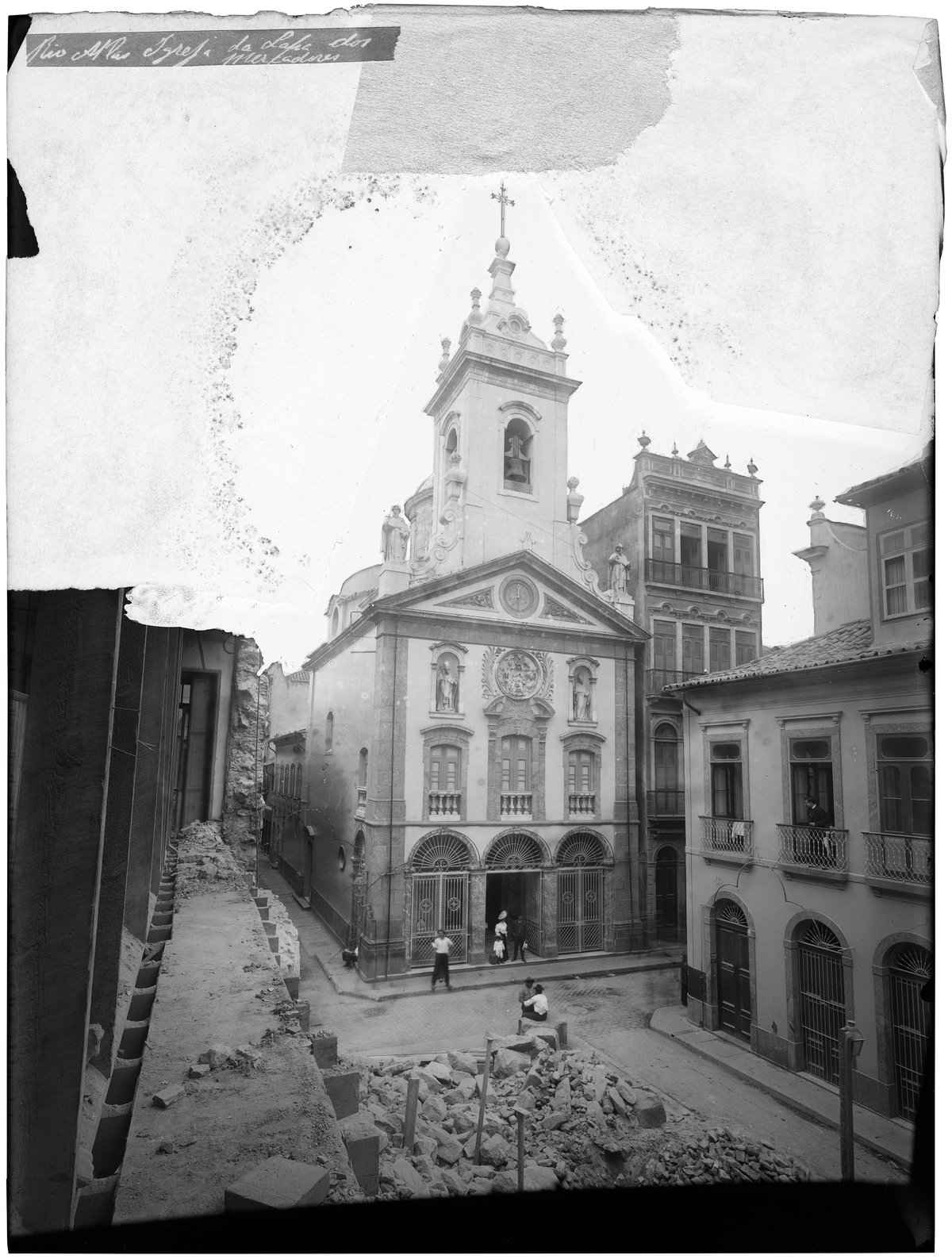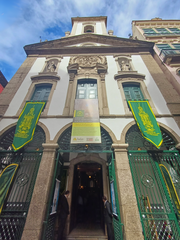
Visiting the Church of Our Lady of Lapa dos Mercadores, Rio de Janeiro: Guide, Tickets, Hours, and Tips
Date: 14/06/2025
Introduction
Nestled in the historic heart of Rio de Janeiro, the Church of Our Lady of Lapa dos Mercadores (Igreja de Nossa Senhora da Lapa dos Mercadores) stands as a testament to Brazil’s colonial heritage, religious devotion, and artistic legacy. Founded in 1743 by a brotherhood of merchants, this remarkable church reflects the intersection of faith, commerce, and community throughout the city’s history. Its richly adorned Baroque architecture, miraculous relics, and ongoing spiritual activities make it a unique destination for both worshippers and travelers.
This comprehensive guide provides a detailed overview of the church’s history, architecture, cultural significance, and practical visitor information—including tickets, opening hours, accessibility, and nearby attractions—so you can plan an enriching visit. For further details and updates, consult official resources and consider using modern tools such as virtual tours and the Audiala app for audio-guided experiences. (source; source; source; source)
Contents Overview
- Early Foundations and Historical Context
- Construction and Architectural Evolution
- 19th-Century Renovations & Historical Events
- Technology and Artistic Legacy
- Visitor Information: Hours, Tickets, and Accessibility
- Travel Tips and Unique Features
- Nearby Attractions
- Religious and Community Significance
- Cultural and Social Role
- Architectural and Artistic Highlights
- Visuals, FAQs, and Interactive Resources
- Contact and Practical Information
- Recommendations and Final Tips
Historical Foundations and Evolution
Early Foundations and Community Context
The origins of the church trace back to 1743, when a brotherhood of merchants established a modest chapel dedicated to Our Lady of Lapa—a Marian devotion with roots in Portugal. This initial structure symbolized the growing influence of lay religious associations in colonial Brazil, which provided both spiritual fellowship and social aid to their communities. The church soon became a focal point for Marian worship, especially after the Jesuits introduced the devotion, weaving it into the religious culture of the Lapa neighborhood (Free Walker Tours).
Construction and Architectural Development (1747–1766)
Fuelled by the economic boom from nearby mining regions, the merchant brotherhood secured royal authorization in 1747 to build a larger, more elaborate church. Construction began in December of that year, with the new church partially consecrated in 1750 and completed by 1755. Final touches to the interior, including intricate woodwork and ceiling paintings, were finished in 1766.
The architectural style is predominantly late Baroque, with a single nave and side chapels designed for both private devotion and public ceremonies. Gilded woodwork, ornate altars, and classical façade elements like pilasters and a triangular pediment reflect the period’s artistic grandeur (source).
19th-Century Renovations & Historical Events
During the 19th century, the church underwent significant renovations (1869–1879) to address structural concerns and update its appearance with neoclassical and eclectic influences. Amid Rio’s urban modernization, the church remained a prominent religious and social landmark.
A pivotal moment in its history came during the 1893 Second Revolt of the Navy, when a cannonball struck the bell tower, toppling a statue dedicated to religion. Miraculously, the statue survived the 25-meter fall virtually unscathed, and both the statue and the projectile are now displayed in the sacristy—a testament to faith and resilience (The Planet D).
Technological and Artistic Legacy
Innovations and Artistic Heritage
The church’s bell tower was equipped with Rio de Janeiro’s first carillon after the 1893 incident, preceding other notable chimes in the city. This addition enhanced both the church’s liturgical functions and its role in the daily rhythm of city life.
Inside, visitors encounter an array of sacred art: gilded woodwork (talha dourada), polychrome statues, vibrant ceiling paintings, and precious liturgical objects. The church’s collection is recognized and protected by Brazil’s National Institute of Historic and Artistic Heritage (IPHAN), underscoring its role as a custodian of national cultural patrimony (World Stock Market).
Religious and Community Significance
Liturgical Life and Spiritual Traditions
The church remains a lively center for Marian devotion, particularly during the annual World Day of the Rosary, which draws worshippers from across the city. Services are accompanied by organ music and choral singing, enhancing the spiritual atmosphere (Diário do Rio).
The parish embraces Rio’s multicultural character, welcoming both Portuguese-speaking and international congregations. English-language services and the involvement of groups like the Our Lady of Mercy Society reflect its inclusive approach.
Miraculous Relics and Cultural Narratives
The church is renowned for its miraculous relics, including the embedded cannonball and the intact statue from the 1893 revolt, reinforcing its reputation as a site of divine protection (The Planet D).
Cultural and Social Role
Community Engagement
Beyond its religious functions, the church acts as a hub for social gatherings, processions, and local festivals. Regular events, such as the Thursday procession of Our Lady of Lapa, foster community bonds and keep traditions alive (The Planet D).
Artistic and Heritage Conservation
Restoration projects have preserved key artistic features, such as the 2023 reactivation of the Italian-made clock and the recovery of sacred artifacts, highlighting ongoing efforts to safeguard the church’s legacy (World Stock Market).
Architectural and Artistic Highlights
Exterior and Façade
The church’s exterior faces Rua do Ouvidor, with a galilee (porch) originally open but enclosed by iron grilles since 1861. The bell tower is a standout, housing Brazil’s first carillon and a recently restored clock. A marble medallion depicting the Crowning of the Virgin, discovered during the 19th century, graces the façade and adds to the building’s historical intrigue (lapadosmercadores.org).
Nave and Chancel
The nave features a luminous space with a crystal and silver-plated chandelier, while the chancel ceiling, painted by Francisco Luiz Garcia Sanches, depicts key events from the Virgin Mary’s life. Delicate stucco reliefs and ornate woodcarvings by Antônio de Pádua e Castro enrich the interior (lapadosmercadores.org).
Atrium of Faith and Relics
In the evocative Atrium of Faith, the statue that miraculously survived the 1893 revolt is preserved. Blue stained glass with the Brotherhood’s insignia and a skylight create a contemplative atmosphere (lapadosmercadores.org).
Artistic Collections
The church’s artistic heritage includes:
- Four large ceiling panels depicting episodes from the life of the Virgin Mary
- 18th- and 19th-century sculptures and religious artifacts
- An archive of early 20th-century photographs and documents, chronicling the community’s history (lapadosmercadores.org)
Visitor Information: Hours, Tickets, and Accessibility
Opening Hours
- Tuesday to Sunday: 9:00 AM – 5:00 PM
- Closed Mondays and on some public holidays
Note: Some sources list slightly different hours; always confirm before visiting, especially during religious holidays or special events (Horários Missa).
Admission
- Entry is free for all visitors; donations are encouraged to support the church’s maintenance and outreach.
Accessibility
- Due to the historic nature of the building, accessibility is limited. Wheelchair access is available via ramps at the main entrance, but some interior areas may be challenging. Contact the church in advance for assistance (Horários Missa).
Guided Tours
- Guided tours, offering insights into the church’s art and history, can be arranged by appointment. Virtual tours are available on the official website.
Getting There and Nearby Attractions
Location
- Address: Rua do Ouvidor, 35, Centro, Rio de Janeiro, Brazil
Directions
- Metro: Carioca Station (Line 1), 10-minute walk
- Bus: Multiple lines serve Avenida Rio Branco and Rua Primeiro de Março
- Walking: The area is pedestrian-friendly and close to major downtown sites
- Car: Limited parking nearby, best to use public transport (Rio Cidade Maravilhosa)
Nearby Attractions
- Arcos da Lapa (Lapa Arches)
- Paço Imperial
- Candelária Church
- Praça XV
- Museu Histórico Nacional
- Selarón Steps
- Local cafés and shops
Visitor Experience and Tips
- Atmosphere: The church offers a serene, intimate setting with baroque and rococo décor, contrasting with the bustling city outside.
- Photography: Non-flash photography is usually allowed; be discreet during services.
- Dress Code: Modest attire is recommended, particularly during religious services.
- Best Time to Visit: Early mornings or late afternoons for quieter visits and better lighting.
- Mass Schedule: Regular masses, including the popular Mass of Our Lady of Graces on the 27th of each month at 10:00 AM.
- Special Events: Annual feast of Our Lady of Lapa on September 8th, processions, and community celebrations.
- Duration: Most visits last 30–60 minutes; allow extra time for reflection or guided tours.
Contact Information
- Address: Rua do Ouvidor, 35 – Centro, Rio de Janeiro, RJ, Brazil
- Phone: +55 (21) 2509-2339
- Email: [email protected]
- Website: lapadosmercadores.org
- Instagram: @igrejalapadosmercadores
Frequently Asked Questions (FAQ)
Q: What are the church’s visiting hours?
A: Generally, Tuesday–Sunday, 9:00 AM–5:00 PM; confirm in advance, especially on holidays.
Q: Is there an entrance fee?
A: No, entry is free; donations are appreciated.
Q: Is the church accessible?
A: Accessibility is limited due to historic architecture; ramps are available at the entrance. Contact staff for assistance.
Q: Are guided tours offered?
A: Yes, by appointment; virtual tours are also available.
Q: Can I attend mass?
A: Yes, regular services are held; check the website for current schedules.
Q: What are some nearby attractions?
A: Arcos da Lapa, Paço Imperial, Candelária Church, Praça XV, and more.
Recommendations for a Memorable Visit
- Arrive Early: Quieter mornings offer a more peaceful experience.
- Combine with Other Sights: Explore Rio’s historic downtown, including nearby churches and museums.
- Participate in a Service: Attending mass or a community event offers unique insight into local traditions.
- Support the Church: Make a donation or purchase a souvenir to help preserve this historic site.
- Enjoy Local Cuisine: After your visit, relax at a nearby café or restaurant on Rua do Ouvidor (Rio.com).
- Plan Ahead: Use the official website for updates and virtual resources.
Visuals and Interactive Media
- High-quality images, a virtual tour, and historical documentation are available on the official website.
- For location and navigation, use Google Maps.
Sources and Official Links
- Flickr Documentation
- Free Walker Tours
- Official Church Website (English)
- Diário do Rio
- The Planet D
- World Stock Market
- Trek Zone
- Riotur
- Horários Missa
- Rio Cidade Maravilhosa
- Sanctuaria
- Wikipedia
- Rio.com
Final Thoughts
The Church of Our Lady of Lapa dos Mercadores is not just a monument to Rio’s colonial past—it is a living symbol of faith, resilience, and community. Its art, history, and ongoing cultural activities offer a multifaceted experience for every visitor. Plan your visit to experience the enduring legacy of this sacred and beautiful site at the heart of Rio de Janeiro (source; source; source).




















































